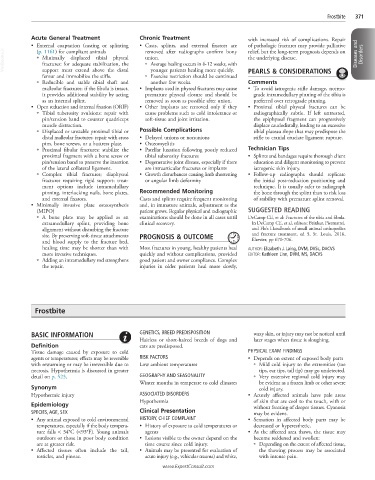Page 783 - Cote clinical veterinary advisor dogs and cats 4th
P. 783
Frostbite 371
Acute General Treatment Chronic Treatment with increased risk of complications. Repair
• External coaptation (casting or splinting • Casts, splints, and external fixators are of pathologic fractures may provide palliative
VetBooks.ir ○ Minimally displaced tibial physeal union. the underlying disease. Diseases and Disorders
(p. 1161) for compliant animals
removed after radiographs confirm bony
relief, but the long-term prognosis depends on
fractures: for adequate stabilization, the
○ Average healing occurs in 6-12 weeks, with
younger patients healing more quickly.
support must extend above the distal
femur and immobilize the stifle. ○ Exercise restriction should be continued PEARLS & CONSIDERATIONS
○ Reducible and stable tibial shaft and another few weeks. Comments
malleolar fractures: if the fibula is intact, • Implants used in physeal fractures may cause • To avoid iatrogenic stifle damage, normo-
it provides additional stability by acting premature physeal closure and should be grade intramedullary pinning of the tibia is
as an internal splint. removed as soon as possible after union. preferred over retrograde pinning.
• Open reduction and internal fixation (ORIF) • Other implants are removed only if they • Proximal tibial physeal fractures can be
○ Tibial tuberosity avulsions: repair with cause problems such as cold intolerance or radiographically subtle. If left untreated,
pin/tension band to counter quadriceps soft-tissue and joint irritation. the epiphyseal fragment can progressively
muscle distraction. displace caudodistally, leading to an excessive
○ Displaced or unstable proximal tibial or Possible Complications tibial plateau slope that may predispose the
distal malleolar fractures: repair with cross • Delayed unions or nonunions stifle to cranial cruciate ligament rupture.
pins, bone screws, or a buttress plate. • Osteomyelitis
○ Proximal fibular fractures: stabilize the • Patellar luxation following poorly reduced Technician Tips
proximal fragment with a bone screw or tibial tuberosity fractures • Splints and bandages require thorough client
pin/tension band to preserve the insertion • Degenerative joint disease, especially if there education and diligent monitoring to prevent
of the lateral collateral ligament. are intraarticular fractures or implants iatrogenic skin injury.
○ Complex tibial fractures; diaphyseal • Growth disturbances causing limb shortening • Follow-up radiographs should replicate
fractures requiring rigid support: treat- or angular limb deformity the initial post-reduction positioning and
ment options include intramedullary technique. It is usually safer to radiograph
pinning, interlocking nails, bone plates, Recommended Monitoring the bone through the splint than to risk loss
and external fixators. Casts and splints require frequent monitoring of stability with premature splint removal.
• Minimally invasive plate osteosynthesis and, in immature animals, adjustment as the
(MIPO) patient grows. Regular physical and radiographic SUGGESTED READING
○ A bone plate may be applied as an examinations should be done in all cases until DeCamp CE, et al: Fractures of the tibia and fibula.
extramedullary splint, providing bone clinical recovery. In DeCamp CE, et al, editors: Brinker, Piermattei,
alignment without disturbing the fracture and Flo’s Handbook of small animal orthopedics
site. By preserving soft-tissue attachments PROGNOSIS & OUTCOME and fracture treatment, ed 5, St. Louis, 2016,
and blood supply to the fracture bed, Elsevier, pp 670-706.
healing time may be shorter than with Most fractures in young, healthy patients heal AUTHOR: Elizabeth J. Laing, DVM, DVSc, DACVS
more invasive techniques. quickly and without complications, provided EDITOR: Kathleen Linn, DVM, MS, DACVS
○ Adding an intramedullary rod strengthens good patient and owner compliance. Complex
the repair. injuries in older patients heal more slowly,
Frostbite
BASIC INFORMATION GENETICS, BREED PREDISPOSITION waxy skin, or injury may not be noticed until
Hairless or short-haired breeds of dogs and later stages when tissue is sloughing.
Definition cats are predisposed.
Tissue damage caused by exposure to cold PHYSICAL EXAM FINDINGS
agents or temperatures; effects may be reversible RISK FACTORS • Depends on extent of exposed body parts
with rewarming or may be irreversible due to Low ambient temperatures ○ Mild cold injury to the extremities (toe
necrosis. Hypothermia is discussed in greater tips, ear tips, tail tip) may go undetected.
detail on p. 523. GEOGRAPHY AND SEASONALITY ○ Very extensive regional cold injury may
Winter months in temperate to cold climates be evident as a frozen limb or other severe
Synonym cold injury.
Hypothermic injury ASSOCIATED DISORDERS • Acutely affected animals have pale areas
Hypothermia of skin that are cool to the touch, with or
Epidemiology without freezing of deeper tissues. Cyanosis
SPECIES, AGE, SEX Clinical Presentation may be evident.
• Any animal exposed to cold environmental HISTORY, CHIEF COMPLAINT • Sensation in affected body parts may be
temperatures, especially if the body tempera- • History of exposure to cold temperatures or decreased or hyperesthetic.
ture falls < 34°C (<93°F). Young animals agents • As the affected area thaws, the tissue may
outdoors or those in poor body condition • Lesions visible to the owner depend on the become reddened and swollen:
are at greater risk. time course since cold injury. ○ Depending on the extent of affected tissue,
• Affected tissues often include the tail, • Animals may be presented for evaluation of the thawing process may be associated
testicles, and pinnae. acute injury (e.g., vehicular trauma) and white, with intense pain.
www.ExpertConsult.com

